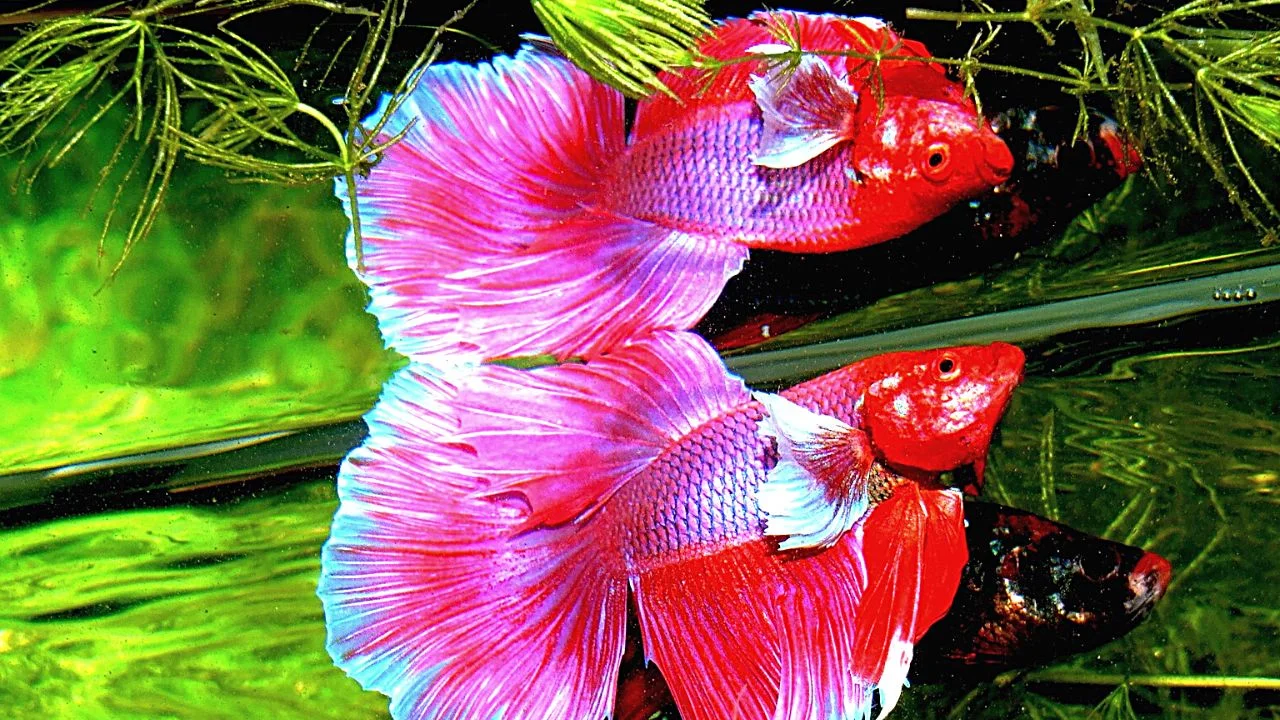
Table of Contents
Betta fish, also famous by the name Siamese Fighting Fish, are one of the best fish for freshwater aquariums. These colourful species are well-liked because of their flowing fins and vivid colours. Their eye-catching look made them perfect for a beginner’s aquarium. However, betta fish demands love and care for its happiness and healthy growth like any other pet.
If you’re new to caring for Betta fish, it might be difficult to know where to start. This beginner’s guide will cover everything you need to know about caring for Betta fish, from setting up the ideal tank to maintaining water quality and temperature, giving them the proper food, and knowing their habits.
Overview of Betta Fish
Betta fish are originally Southeast Asian species. There are more than 70 species of betta fish, with Betta Splendens (Siamese Fighting Fish) being the most famous. Some other popular kinds of betta fish include the half moon, crown tail, and double tail. One of the most beautiful facts about this species is that it has unique colour patterns, fin shapes, and other physical characteristics that make them distinct from each other.
Generally, Bettas are found to be small, often reaching lengths of 2 to 3 inches. The length of Betta fish depends on many factors like species, age, and how you care. Interestingly, Betta Fish have an organ called a “Labyrinth” that helps them breathe air from the surface, which means Bettas can survive in low-oxygen environments.
Their Amazing looks come with vibrant colours and flowing fins in a range of hues, including blue, red, and purple, to mention a few. Male Bettas are more colourful with extended fins than females and therefore are more popular with hobbyists.
Setting Up a Betta Fish Tank
Understanding the correct tank setup and proper care for Betta fish is mandatory to grow them well. With that said, Let’s move to the tank setup.
Choosing the Right Tank
Size is one of the most crucial considerations when choosing a tank. A larger tank is always preferable since it allows for better filtration and water quality and more swimming area. A minimum of 5-gallon tank is recommended for a single Betta, while 10 gallons or more is preferable. When it comes to the shape of the tank, a Rectangular or square one is more beneficial for your Betta fish than a circular or bowl-shaped one, as it provides more surface area for oxygen change and better swimming space.
NOTE: Make sure your tank has a secure, tight-fitting lid to prevent your Betta from leaping out or other animals from getting in.
Essential Equipment
It’s crucial to have the appropriate equipment to keep your Betta healthy and happy. The important one is the Filter. A filter helps to maintain the water quality by eliminating dangerous chemicals, dirt, and trash. A heater is also important as it maintains the optimal temperature in your fish tank. A thermometer to check water temperature and an aquarium light to mimic their day and night cycle is also necessary. Other required tools include a gravel vacuum that is used for cleaning the substrate, a fishnet for catching your betta fish, and a water testing kit to keep track of the water quality.
You may give your Betta fish a safe, healthy environment that resembles their natural home by investing in appropriate tools.
Water Conditions
The health and well-being of your Betta fish depend on the creation and maintenance of appropriate water conditions. Since bettas are delicate fish, poor water quality can cause stress, illness, and even death. The pH range for Betta fish is 6.5 to 7.5; the water hardness range is 5 to 20 dGH. Tap Water may contain hazardous contaminants, so before adding this water to your tank, you should add a water conditioner to neutralize these dangerous contaminants.
Test the water parameters using a reliable water test kit, and adjust water conditions as necessary.
Maintaining the Suitable Temperature
Betta fish are tropical fish that love warm water ranges to swim. In my opinion, it would be 76°F to 82°F is the most optimal range for Bettas. Make sure whether you have to increase or decrease the water temperature, make it slow and steady.
NOTE: Sudden Temperature changes in your Tank water may cause stress, illness, and even death to your aquatic creatures.
Try to read thermometer readings regularly and keep the water temperature in above mentioned optimal ranges.
NOTE: Keep your tank away from direct sunlight, drafty places, and heat sources to avoid temperature fluctuations.
Tank Maintenance
Water quality is critical to the general health of Betta fish. It has a direct impact on their respiratory, metabolic, and immunological systems. Poor water quality increases stress and illness vulnerability, whereas excellent circumstances promote brilliant colours and energetic behaviour.
The Nitrogen Cycle:
It is critical to establish the nitrogen cycle before adding your Betta fish. The development of helpful bacteria converts poisonous ammonia (from fish waste and uneaten food) into nitrites, which are then converted into less damaging nitrates. Test water parameters regularly to verify that ammonia and nitrite levels stay nil while nitrates remain below 20-40 ppm.
Cycling the Tank:
Cycling your tank promotes the colonization and maturation of beneficial microorganisms. Begin the cycle by introducing a source of ammonia, such as fish food or pure ammonia drops. Be patient during this procedure since the cycle may take many weeks to complete.
Partial Water Changes:
A crucial feature of water quality control is partial water changes regularly. Using a siphon to remove debris from the substrate, aim to replace 20-30% of the water per week. Use a water conditioner to eliminate dangerous chlorine and chloramine from the new water.
Filtration and aeration:
To remove pollutants and debris from the water, a robust filtering system is required. Choose a filter that is appropriate for the tank size and delivers smooth water flow to avoid stressing your Betta. If your filter generates strong currents, consider baffling the flow with decorations or sponge filters.
Cleaning Routine:
Clean the tank walls and decorations regularly with a soft sponge or algae scraper. Chemical cleansers might be harmful to your Betta. To ensure efficient filtration, clean and replace filter media according to the manufacturer’s instructions.
While cleanliness is essential, overcleaning the tank can disturb the nitrogen cycle and beneficial bacterial colonies. A well-established environment is critical for the health of your fish.
Compatible Tank Mates for Bettas:
While Bettas can be territorial and aggressive towards particular fish, many calm alternatives can cohabit peacefully. You may establish a thriving and entertaining community aquarium by carefully selecting suitable tank mates. Here are some tank mates that will get along with your Betta fish:
Java Moss
Java moss (Taxiphyllum Barbieri) is an excellent tank companion for Betta fish. It is an excellent addition to any Betta fish tank, boosting the beauty and well-being of your aquatic friends with its capacity to survive in a variety of water conditions and basic Java moss care needs, such as frequent trimming and debris cleaning.
This low-maintenance aquatic plant offers several advantages to the aquarium environment. Betta fish may hide in its dense, luxuriant growth, which reduces stress and aggressiveness. Furthermore, Java moss is an excellent material for Betta bubble nests during breeding and provides refuge for fry. It also serves as a natural water filter, which contributes to better water quality.
Peaceful Schooling Fish
Betta tank mates should ideally be little schooling fish. They prefer to be alone and are less prone to initiate confrontation. Some common choices are:
- Neon tetras
- Harlequin rasboras
- Ember tetras
- Cherry barbs
- Endler’s livebearers
Bottom Dwelling Fish
Fish that live largely at the tank’s bottom might make excellent Betta buddies. They live in a distinct area of the aquarium, limiting the possibility of confrontation. Consider including:
- Corydoras catfish (various species)
- Kuhli loaches
- Bristlenose plecos
Peaceful Mid-Level Swimmers
Bettas get along nicely with fish that live in the tank’s intermediate levels. These fish are usually harmless and can offer diversity to the tank. Some possible alternatives include:
- Cherry or tiger barbs (in groups of 5 or more to prevent fin nipping)
- Platy fish
- White cloud mountain minnows
Snails and Shrimp:
Consider adding snails and prawns to your aquarium in addition to fish. They are quiet and may improve the tank’s environment by cleaning off dirt and algae. Popular options include:
- Nerite snails
- Amano shrimp
- Cherry shrimp
Female Betta Sorority:
A unique female Betta sorority may be created in bigger tanks (20 gallons or more). Female Bettas are less aggressive than male Bettas and can live in groups of five or more. To reduce hostility, introduce them all at once.
When introducing new tank mates, it is critical to closely observe their behaviour for the first several days. If aggressive behaviour is seen, have a backup plan in place to rehome or remove the troublesome fish.
Note: Remember that each Betta has its unique personality, so individual compatibility may vary.
Providing Proper Nutrition to Your Bettas
Bettas require a well-balanced diet that contains protein as well as plant-based items. Understanding their nutritional requirements and establishing a feeding schedule is critical to ensuring your Betta flourishes.
As your primary feeding source, invest in high-quality commercial Betta fish pellets or flakes. Look for items that are particularly made for Betta fish since they contain necessary nutrients and are tailored to fulfill their nutritional needs. Avoid purchasing generic fish food designed for other species since it may be deficient in critical nutrients required for Betta fish.
To avoid water quality concerns, all uneaten food should be removed from the tank as soon as possible. Excess food allowed to rot in the water might contaminate it and kill your Betta.
Note: Never feed your Betta fish human food since it may contain dangerous substances. Bread, grains, and processed foods might cause stomach problems and endanger their health.
Conclusion
In conclusion, giving correct care to Betta fish is critical to their well-being and enjoyment in the aquarium. We can imitate their native habitat and provide a stress-free existence for these gorgeous fish by providing a suitable environment with the ideal tank size, acceptable water conditions, and interesting décor. Maintaining water quality through frequent testing and partial water changes is important for their health and lifespan.
Feeding Betta fish a well-balanced diet that includes both protein-rich meals and treats helps to maintain their brilliant colours and general vigour. Furthermore, monitoring their behaviour and swiftly addressing any indicators of stress or sickness helps avert possible problems and provide early intervention if necessary.
Betta fish may become valued friends with appropriate care and attention, bringing beauty and delight into our lives as we work to establish a healthy and peaceful aquatic world.

Josh Wayne
Josh is the owner and founder offitaquarium.com– A blog that aims to help aquarium hobbyists with their queries about fish keeping. Josh enjoys sharing his expertise and insights with fellow hobbyists. Follow him on Instagram @fit_aquarium or reach out via email at josh@fitaquarium.com.



